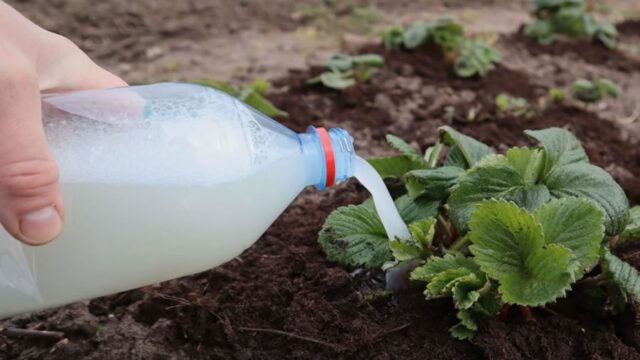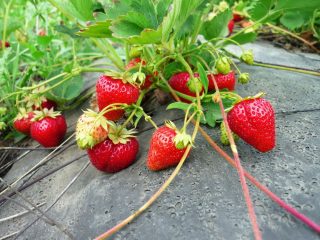Content
Superphosphate for strawberries is equally important in both spring and autumn. Fertilizing must be done in accordance with certain rules and in small volumes.
Is it possible to feed strawberries with superphosphate?
Strawberry bushes place quite high demands on mineral fertilizing. For successful development and abundant fruiting, they need to be fertilized with all the basic substances - nitrogen, potassium and phosphorus. In this case, the latter plays a particularly important role, since it is responsible for the formation of large and juicy berries, for their sweetness and resistance to crushing.
Superphosphate is a popular and widespread fertilizer that is used when growing vegetable and fruit crops. Fertilizer is divided into two main types:
- Simple superphosphate. In addition to phosphorus, it includes impurities of gypsum, fluorine, iron and aluminum phosphates, as well as silica.
- Double superphosphate. As the name suggests, it contains double the amount of phosphorus, as well as small amounts of gypsum, boron, molybdenum, manganese or ammonia, depending on the specific variety.
In appearance, simple and double superphosphate are practically indistinguishable. The properties of the drugs are also very similar, but products with a higher phosphorus content have a faster and more noticeable effect on the crop.

On sale, simple and double superphosphates are found in the form of gray powder or in granular form.
Signs of phosphorus deficiency in strawberries
It is recommended to use superphosphate fertilizer for strawberries on an annual basis. In some cases, special attention must be paid to the application of the drug, adding it to the soil more often than usual. This must be done if there are characteristic symptoms indicating a lack of phosphorus in the beds:
- for rust on strawberry leaves;
- when the plates darken;
- when folding leaves;
- for small, dry and deformed berries.
The listed symptoms may appear on strawberries during periods of sudden temperature changes. But if, after the establishment of stable heat, the situation does not change, we can make an unambiguous conclusion about a phosphorus deficiency in the soil.
What soil is superphosphate suitable for?
Strawberries need phosphorus equally well on any soil. However, the effectiveness of the substance is not the same for different soils. It is best absorbed in soil with an alkaline or neutral pH.
If the soil is acidic, then there will be practically no results from adding phosphorus. Before using fertilizer, it is recommended to pre-lime the area.

Superphosphate is not completely absorbed by the soil, so the possibility of overdose when fertilizing is practically excluded
Timing for applying superphosphate for strawberries
It is recommended to fertilize strawberries with phosphorus two to four times per season. Typically, fertilizing is applied:
- in early spring after the soil thaws;
- at the end of flowering;
- after harvest;
- before the onset of cold weather.
There is only one main condition for applying fertilizers: the soil temperature must be at least 10 °C. There is no point in adding phosphorus to cold soil, since strawberries will not be able to absorb it. The main part of the fertilizing will simply go into the deep layers of the soil.
How to fertilize strawberries with superphosphate
When applying phosphorus to strawberries, you need to follow some important recommendations. Fertilizer can be added either in its pure form or in combination with other beneficial substances.
Fertilizing strawberries with superphosphate in the fall
Autumn fertilizing with phosphorus helps strawberries regain strength after fruiting. Berry bushes receive vitamins and minerals from the soil, store new resources to replace those spent, and gain strength before leaving for the winter.
Most often, one of three solutions is prepared for application to the soil:
- Simple feeding. In 10 liters of lukewarm, settled water, dilute 10 g of double superphosphate and stir until completely dissolved. The resulting liquid is poured between the rows, trying to evenly cover all the bushes. Double superphosphate for strawberries after fruiting is especially good at restoring the plant's strength.
Phosphorus fertilizing additionally increases the resistance of strawberries to fungal diseases
- With added nitrogen. Add 1 liter of mullein infusion to 10 liters of water, then add a glass of wood ash and 2 large spoons of superphosphate.This mixed fertilizer contains not only phosphorus, but also a small amount of nitrogen.
- Complex minerals. You can fertilize strawberries with superphosphate in the fall according to this scheme: 40 g of phosphorus powder and 30 g of potassium sulfate are dissolved in 10 liters of water. The resulting liquid is watered generously at the roots of the bushes. You can also simply scatter the fertilizer over the beds in dry form and incorporate it into the soil, after which it should be properly moistened.
Phosphorus-potassium solution strengthens strawberry roots and protects them from drying out and freezing
After applying double superphosphate for strawberries in the fall or when using regular fertilizing, it is recommended to mulch the soil with straw. This will prevent premature evaporation of water and increase the duration of action of fertilizers. If autumn is damp and the soil in the garden beds is too wet, it is better to incorporate phosphorus into the soil in dry form.
Application of superphosphate in spring under strawberries
By default, it is believed that it is better to apply phosphorus fertilizers in the autumn. There is a rational grain in this, since the substance is absorbed for a long time, and it is most convenient to add it just before the onset of the rest period.
However, on difficult soils and in poor condition of the berry crop, you can dilute superphosphate to feed strawberries in the spring. It is recommended to do this no earlier than mid-April, after the snow has completely melted and the soil has moderately warmed up.
The solution for fertilizing strawberries is prepared as follows:
- Pour 1 kg of double superphosphate into a bucket and pour in 5 liters of hot water.
- Stir the powder or granules until well dissolved.
- Leave covered for a day.
- After time, stir the fertilizer in the water again.
- Add 5 liters of clean liquid.
To fertilize strawberries with superphosphate in the spring, the resulting mother solution is additionally diluted with water in a ratio of 1:10 and used for watering the beds. For each bush you need to spend about 500 ml of the drug.

A spring lack of phosphorus can result in a decrease in yield and shredding of berries
Conclusion
Superphosphate for strawberries is of particular importance, since it is responsible both for the fruiting of the crop and for the health of the bushes in general. It is recommended to apply it to the soil 2-4 times per season, depending on the quality of the soil and the condition of the plant.










